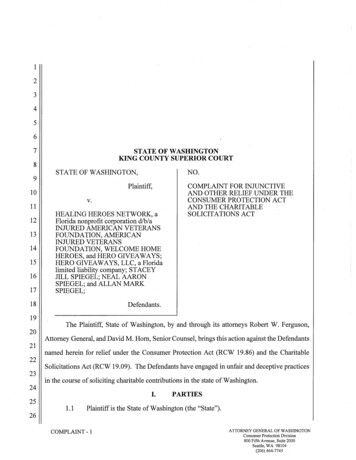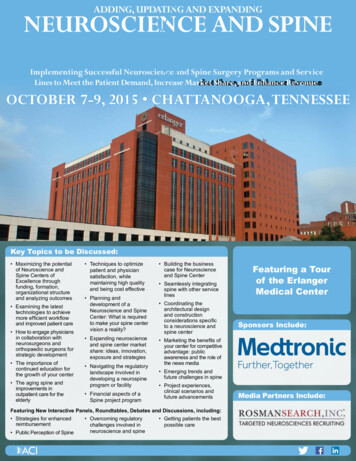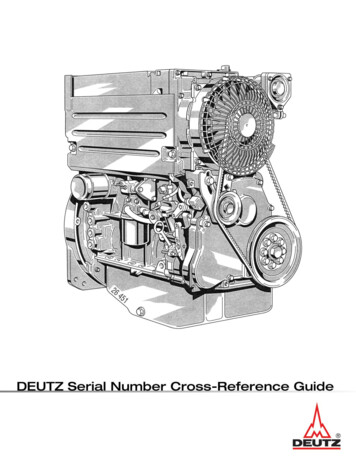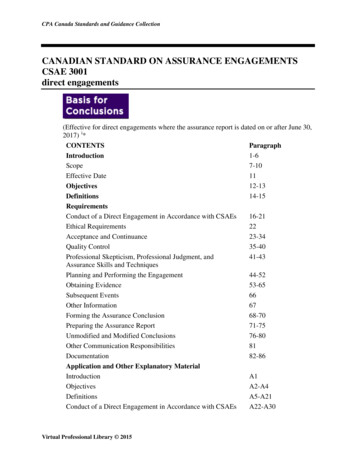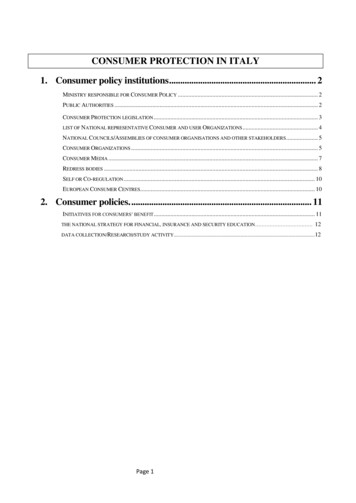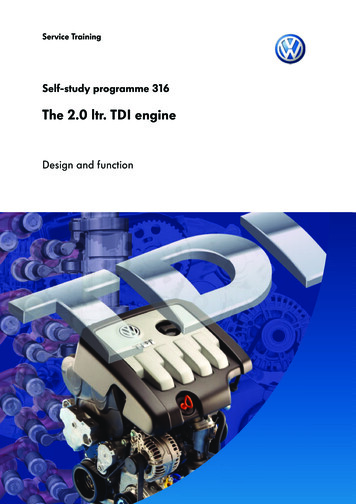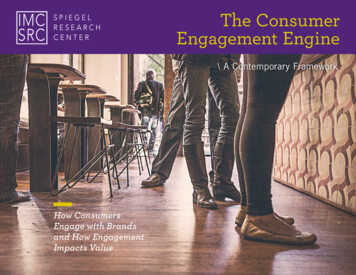
Transcription
The ConsumerEngagement Engine\ A Contemporary FrameworkHow ConsumersEngage with Brandsand How EngagementImpacts Value
\ Executive SummaryA New Framework for UnderstandingHow Consumers Engage with Brandsand How Engagement Impacts ValueMarketing practitioners know that for brands to successfully influence today’s consumer, brands must engage more effectively and relevantly. And they must do so innew and possibly unfamiliar ways.The engagementknowledge gapAlthough the topic of engagement isregularly researched and discussed, thecontemporary dynamic for how engagement occurs has not been adequatelyexplained. We believe this confusionstems from using a framework that wasonce revered but now is antiquated.“The Funnel,” based on the AIDA Modelthat St. Elmo Lewis developed morethan a century ago, does not adequatelyreflect the dynamic, multidirectional,and always-on ways that consumers andbrands engage with each other in today’sdigital landscape.2Our researchNorthwestern University’s Medill IMCSpiegel Digital & Database ResearchCenter has conducted research intohow consumers engage with brandsand how this engagement impacts customer value. From this research, we havedeveloped an alternative framework,the Consumer Engagement Engine. Thisframework demonstrates how marketersmust engage with consumers based onhow consumers are engaging with oneanother and with brands.\ The Consumer Engagement Engine \ spiegel.medill.northwestern.eduQUESTIONS WE ADDRESSThis report will help marketers answer many of the mostpressing questions they face about consumer engagement: re your current engagement strategies effectivelyAgrowing customer value? hich types of customer engagement drive theWmost value? ow important are your existing customers in drivingHawareness and engagement? o your engagement strategies drive relevantDinteraction between your customers and your brand? re you simply broadcasting messages and expectingAthem to drive engagement? Or are you listening toyour audience and responding in ways that they wantto engage with you?
Replacing “The Funnel”with “The Engine”Why the Consumer Engagement Engineprovides a framework for understanding theways that engagement grows value today.3\ The Consumer Engagement Engine \ spiegel.medill.northwestern.edu
The Funnel’s Digital DisconnectFor more than a century, marketers have relied on theAttention-Interest-Desire-Action (AIDA) Model, developed byElias St. Elmo Lewis in 1902, to understand how consumerslearn about and take actions related to brands.The growing influence of the consumer’s voice in an always-ondigital environment, however, has made obsolete many of theassumptions that underlie the funnel-based view of howconsumers and brands engage with each other.Funnel assumptions: ngagement is a linear process withEa distinct beginning and end ommunications are initiated andCcontrolled by the brand he only communications thatTinfluence the purchase are betweenthe consumer and the brand4\ The Consumer Engagement Engine \ spiegel.medill.northwestern.eduATTENTIONGrab their AttentionBuild their InterestINTERESTDESIRECreate the DesirePersuade themto take ActionACTIONConsumer engagement isno longer explained by afunnel that is managed bythe brand.
01His interest piqued,Evan heads to TrueCarto see how much anew Prius costs.Evan is planning ongetting a new car inthe next six months,but the Toyota Priushadn’t been on hisradar until he sees hisfriend Paige’s tweet. Evan McG51:Sweet ride, @Paige 1985!How EngagementWorks for theDigital Consumer03Now Evan is curiousto see what his otherfriends have to say. Logan8757:@Evan McG51, you’llhave to let me have atest drive sometime!06Of course, the first thing Evandoes when he gets home is totweet about his car. After amonth, he has become sucha fan of his car that he startsblogging about all of the roadtrips he can now afford to goon in his fuel-efficient hybrid.\ The Consumer Engagement Engine \ spiegel.medill.northwestern.eduHeather: Yes!!!I LOVE mine!Ryan: My sister got one,and she seems to like it.No longer a linear process where the consumer moves neatly from the top of the funnelto the bottom, all while interacting directly with the brand, today’s consumer journeyoften is initiated by peers and involves many non-brand third parties along the way. Evan McG51:Just brought thisbaby home #Prius#SweetRide #GreenRide502Paige 1985:Lovin’ my new #PriusEvan: Hey Facebookfriends, I’m thinking aboutgetting a Toyota Prius. Doyou think I should do it?05Evan loved the test driveand he was able to beatthe pricing shown onTrueCar, so he makes thepurchase and drives homewith a brand new Prius!04While checking footballscores that weekendon ESPN.com, Evansees a retargeting adfrom Toyota advertisinga year-end sale. SoEvan decides to headto his local dealer fora test drive.
Introducing: The Consumer Engagement EngineEngagement in today’s digital communications ecosystem works not like a funnel but like anengine where brands and consumers are synergistically interacting with each other in newways that can have a powerful impact on customer iorsBrand DialogueBehaviorsBrandConsumption6\ The Consumer Engagement Engine \ spiegel.medill.northwestern.edu
Defining Characteristics of theConsumer Engagement EngineWhile the Consumer Engagement Engine differs from thetraditional funnel in many ways, these five characteristicsare particularly important to marketers looking to engagewith consumers in relevant and valuable ways.The engine is elegant: It’s made of five interlocking components: brand actions,customer motivations, purchase behaviors, brand consumption, and brand dialoguebehaviors. Consumers are constantly being influenced by messages from friends,social networks, strangers, the media, and intermediaries—messages that are sentand delivered across numerous platforms and devices.There is no on/off switch: Unlike the funnel, which represents engagement as alinear process with a beginning and an end, the engine reflects the always-on stateof engagement. Unlike the funnel’s “end,” often the purchase is the catalyst for thestart of new and enhanced levels of engagement. The engagement engine is in perpetual motion.Brand Actions are just one of the cogs: The brand no longer controls when and howconsumer engagement occurs. Today, customers or other actors are just as likely asmarketers to initiate brand-related communication. Brands are moving from beingbroadcasters to being sPurchaseBehaviorsBrand DialogueBehaviorsBrandConsumption7\ The Consumer Engagement Engine \ spiegel.medill.northwestern.eduUsers of the brand are vital: Buyers’ brand consumption experiences—good or bad—are fuel for sharing. The good ones positively power the engine.Brand dialogue behavior is the biggest cog: Our research found that non-purchasebehaviors, or “brand dialogue behaviors” (BDBs), have the greatest impact onfuture engagement. We uncovered powerful insights about how BDBs are drivingcustomer lifetime value. Throughout the rest of this report, we will examine BDBsand their role in driving value.
Understanding and RankingBrand Dialogue BehaviorsWhat we discovered about the relative valueof engagement across the BDB hierarchy haspowerful implications for marketers.8\ The Consumer Engagement Engine \ spiegel.medill.northwestern.edu
The Many Forms ofBrand Dialogue BehaviorsWe’ve found that the types of engagement that frequently had the greatest impacton consumers were brand dialogue behaviors (BDBs), which can involve consumers,other purchasers, non-purchasers, and the brand itself. We also found that theseBDBs currently lack a categorization, taxonomy, or ranking according to the valuethey create for the brand.Brands need to better understand the opportunity presented by BDBs, as well as thebrand’s role in BDBs—a role that involves enhancing the customer experience and/orlistening and responding to the engagements.Common forms of brand dialogue behaviors include: Viewing brand-focused videos Liking a friend’s post about a brand Posting a consumer review Checking in at a store on a smartphone Getting a brand tattoo Participating in a brand-sponsored contest Filling out a survey Discussing a brand with a friend at a party Downloading branded apps Contacting a brand’s customer support And many more9\ The Consumer Engagement Engine \ spiegel.medill.northwestern.edu
3. CO-CREATION:The Brand DialogueBehavior HierarchyBDBs can be categorized into threedistinct types, all of which have anincreasing degree of interactivity andvalue for the brand: observation,participation, and co-creation.Let’s see how Evan, the new Prius ownerand enthusiast, fits into this hierarchy.102. PARTICIPATION:1. OBSERVATION:“Lean back” behavior wherethe consumer takes a passiverole, such as Evan seeingPaige’s tweet about her newPrius or looking at the retargeting ad on ESPN.com.\ The Consumer Engagement Engine \ spiegel.medill.northwestern.eduWhen Evan replied to Paige’stweet and when he visitedTrueCar.com to look up theprice, he was taking an activerole in engaging with the brand.Evan’s blog about his Prius roadtrips is an example of co-creation. Other common forms ofco-creation include participating in a contest to create a newflavor of potato chips, writing aproduct review, or voting on thewinner of a reality TV show.
Greater Relevant EngagementDrives Greater Customer ValueWe found that as consumers engage more actively and in ways thatinvolve relevant interaction with the brand, there is a strong correlationto increasing levels of customer lifetime value.Impact on Customer ValueCO-CREATIONPARTICIPATIONOBSERVATIONExtent of Customer Engagement11\ The Consumer Engagement Engine \ spiegel.medill.northwestern.edu
How Brand Dialogue BehaviorDrives Customer Lifetime ValueAcross all levels of the BDB hierarchy—observation, participation, and co-creation—we found that there are two primaryfactors that determine a BDB’s impact on customer value:brand and personal-goal relevance and level of engagement.Brand and Personal-Goal RelevanceThis measure refers to the degree that the behavior relates to the consumer’s personal brand and category-related goals. Brands should avoid investing in engagement strategies that don’t lie at the intersection of the consumer’s personal goalsand how the product or service helps the consumer attain that goal. For example,our research into a travel rewards program’s social media contests found thattopics that were closely related to travel generated much higher engagement thannon-travel topics such as “mommy moments” and “living greener.”Levels of EngagementThe greater the active engagement with a brand, the more this engagement willadd value to the relationship for the brand. Our research into the travel rewardsprogram found that respondents who posted long responses increased their purchases by 80% after the contest while respondents with shorter posts increasedtheir purchase by only 49%.Posters Who Elaborate More Spend MoreLong PostsShort PostsLEARN MORE edia-contests.html12\ The Consumer Engagement Engine \ spiegel.medill.northwestern.edu0%50%100%Increase in Post-Contest Spending
Using the Customer Engagement Engineto Improve Customer ValueFive insights to help marketers improveengagement with their brands13\ The Consumer Engagement Engine \ spiegel.medill.northwestern.edu
How Marketers Can Rev theEngagement Engine forTheir BrandsThese five recommendations will help marketing practitionersand brands engage with consumers in ways that lead toimproved customer lifetime value within the ConsumerEngagement Engine.1. A DOPT THE ENGINEUse the framework to better engageand drive value for your brand AP YOUR ENGAGEMENT2. MIdentify where your engagement efforts lieon the brand dialogue behavior hierarchy3. I NVEST IN YOUR CUSTOMERSInvest heavily in customer experiences andhelp this audience become your BehaviorsBrand DialogueBehaviorsBrandConsumption14\ The Consumer Engagement Engine \ spiegel.medill.northwestern.edu RIVE RELEVANT ENGAGEMENT ONLY4. DStimulate only the types of engagement thatcreate a relevant connection to the brand5. L ISTEN AND RESPONDUse social media to be a responder,not just a broadcaster
\ Managerial Implication No. 1:Adopt the Engine as a Framework forUnderstanding How Engagement Is—or Is Not—Driving Value for Your BrandAre your current engagement strategies effectivelygrowing customer value?Adopting the Consumer Engagement Engine framework is an important firststep for brands struggling to understand how engagement occurs in today’smarketing landscape. Adopting the engine mindset will help brands assess notonly how their own actions are driving engagement, but also how the actionsof consumers and other players are creating engagement.HOW IT WORKS:Within the engine framework, brands should rethinkpast assumptions, such as “mobile doesn’t convert.”Because brand dialogue behaviors play such a largerole in influencing consumers, brands should measurethe immediate and long-term impact of engagementon customer value, not just conversion or directrevenue generation.CASE EXAMPLE:Technology companies using the “freemium” model,such as Spotify, understand that even listeners whonever purchase a paid subscription create value forthe brand by sharing their favorite songs and playlistsacross social media.15\ The Consumer Engagement Engine \ spiegel.medill.northwestern.edu
\ Managerial Implication No. 2:Identify Where Your EngagementStrategies Lie on the Brand DialogueBehavior HierarchyWhich types of customer engagement drive themost value?The hierarchy of brand dialogue behaviors—observation, participation, andco-creation—has powerful implications for marketers as they seek to increasecustomer lifetime value with improved levels of interactivity and relevance.Marketers should use this hierarchy to evaluate their existing engagementefforts and develop new ones.HOW IT WORKS:Brands should expand or recalibrate their ROImeasures to account for the relative impact thatBDBs have on customer value across the three levelsof the hierarchy. Accordingly, brands should investmore resources in campaigns that spur participationand co-creation.CASE EXAMPLE:Doritos’ “Crash the Super Bowl” contest rewards fansfor submitting ad ideas and then allows other fans toparticipate by voting on the winner.16\ The Consumer Engagement Engine \ spiegel.medill.northwestern.edu
\ Managerial Implication No. 3:Invest Heavily in Customers andTheir ExperiencesHow important are your existing customers in drivingawareness and engagement?It’s common for marketers to focus on chasing new customers, but currentcustomers are the ones engaging in brand dialogue behaviors that areauthentically engaging prospects.HOW IT WORKS:Understand that a customer’s value to a brand as anadvertiser or ambassador may greatly outweigh hisor her value as a future purchaser. Investments thatimprove the quality of a customer’s experience will oftenbe leveraged across that customer’s social networks.The Consumer Engagement Engine shows that existing customers, who areincreasingly empowered to share their experiences and create other forms ofbrand-related content, play an outsized role in building awareness and affinityfor your brand. Your customers become your advertisers.CASE EXAMPLE:Spiegel’s research into data provided by Peapod andthe Air Miles rewards program found that relevantbranded apps will add value to the customer experience and grow revenues. To read our analysis ofhow Peapod customers’ adoption of mobile shoppingaffected subsequent purchase behavior and how AirMiles members’ purchase behavior correlates withtheir use of the app, visit:spiegel.medill.northwestern.edu/studies/17\ The Consumer Engagement Engine \ spiegel.medill.northwestern.edu
\ Managerial Implication No. 4:Stimulate Only the Types of Engagementthat Drive Relevant Connection toYour BrandDo your engagement strategies drive relevantinteraction between your customers and your brand?Our research found that in order for engagement to create value for the brand,the engagement needs to lie at the intersection of the consumer’s personalgoals and how the product or service contributes to the consumer attainingthose goals. Brand engagement that is irrelevant to the brand will have littleeffect on future loyalty and purchase behavior or—like bad advertising—could even be detrimental.HOW IT WORKS:The need to focus on brand and personal-goalrelevancy is particularly important when it comesto co-creation campaigns. Resist the temptation toinvite consumers to create content on themes thataren’t related to the brand’s core value proposition.CASE EXAMPLE:Spiegel’s research into Air Miles’ social contestsfound that prompts that were highly relevant totravel rewards generated dramatically more engagement, which leads to increased customer lifetimevalue, than non-relevant contests. For example,prompts that asked members to share how they planon redeeming their miles generated significantlymore engagement than prompts related to “mommymoments” and “living green.” Learn more at:18\ The Consumer Engagement Engine \ hwestern.edu/studies/
\ Managerial Implication No. 5:Be a Monitor and Responder onSocial Media—Not Just a BroadcasterAre you simply broadcasting messages and expecting themto drive engagement? Or are you listening to your audienceand responding in ways that the audience wants to engagewith you?Under the funnel view where brands control engagement, it may be enoughto simply use social media as an additional channel for disseminating marketing messages. The Consumer Engagement Engine, however, illustrates thatlistening to the conversations that are going on about the brand and responding to those conversations is extremely valuable for brands. This also meansthat brands need to be paying close attention to how consumers are engagingwith each other, not just with the brand.HOW IT WORKS:When creating budgets and goals for a social strategy,listening and responding need to be prioritized. Significant resources should be allocated to building a teamthat can monitor conversations and respond to engagedaudiences in real time. Also, social ROI models shouldreflect the importance of listening and responding.CASE EXAMPLE:Taco Bell has built a “newsroom” for its social mediateam, which allows the team to be constantly monitoringand responding to conversations involving the brandaround the world.19\ The Consumer Engagement Engine \ spiegel.medill.northwestern.edu
The ConsumerEngagement Engine:Review the ResearchAs marketing practitioners continue to adapt to theopportunities and challenges presented by today’srapidly evolving communications landscape, webelieve the Consumer Engagement Engine will be avaluable tool for helping marketers engage with existing customers, prospects, intermediaries, and otheractors in ways that create value for the brand.Consumer EngagementResearch TeamThe research supporting this report was led by thefollowing members of the Spiegel Research Center:Tom CollingerExecutive Director and Associate ProfessorEdward MalthouseProfessor of Integrated Marketing CommunicationsEwa MaslowskaAdjunct Lecturer and Research Associate20\ The Consumer Engagement Engine \ spiegel.medill.northwestern.eduLEARN MORE about the Spiegel Research Center’s research-driveninsights on marketing communications by visiting:spiegel.medill.northwestern.edu
About the Spiegel Research CenterUnderstanding Customer Engagement that Drives Business PerformanceThe Medill IMC Spiegel Digital & Database Research Center is the first research center at the MedillSchool of Journalism, Media, Integrated Marketing Communications. It was founded in 2011 by agenerous gift from the late Professor Emeritus Edward J. “Ted” Spiegel and his wife Audrey andfortified by the support of corporations, alumni, and friends. The center is part of Northwestern’s longtradition of applied research about advertising and marketing. The focus of the Spiegel Research Centeris to do evidence-based, data-driven analysis to prove the relationship between customer engagementand purchase behavior. The center’s research focuses on consumer behavior in social media and onmobile devices.21\ The Consumer Engagement Engine \ spiegel.medill.northwestern.edu
spiegel.medill.northwestern.edu/studies/ social-media-contests.html 12 \ The Consumer Engagement Engine \ spiegel.medill.northwestern.edu Posters Who Elaborate More Spend More Long Posts Short Posts 0% 50% 100% Increase in Post-Contest Spending


